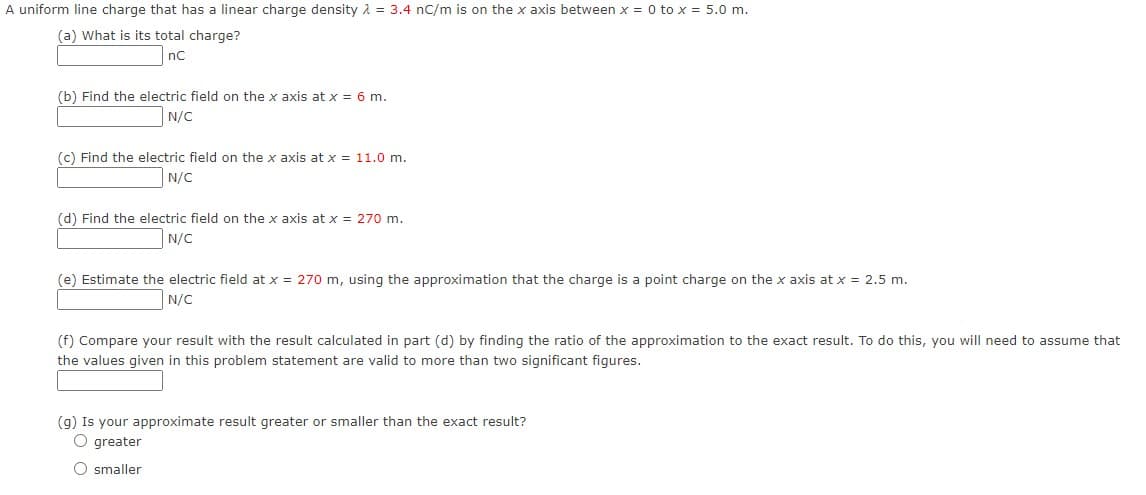A uniform line charge that has a linear charge density 2 = 3.4 nC/m is on the x axis between x = 0 to x = 5.0 m. (a) What is its total charge? nC (b) Find the electric field on the x axis at x = 6 m. N/C (c) Find the electric field on the x axis at x = 11.0 m. N/C (d) Find the electric field on the x axis at x = 270 m. N/C
A uniform line charge that has a linear charge density 2 = 3.4 nC/m is on the x axis between x = 0 to x = 5.0 m. (a) What is its total charge? nC (b) Find the electric field on the x axis at x = 6 m. N/C (c) Find the electric field on the x axis at x = 11.0 m. N/C (d) Find the electric field on the x axis at x = 270 m. N/C
Physics for Scientists and Engineers with Modern Physics
10th Edition
ISBN:9781337553292
Author:Raymond A. Serway, John W. Jewett
Publisher:Raymond A. Serway, John W. Jewett
Chapter24: Electric Potential
Section: Chapter Questions
Problem 45AP: A solid, insulating sphere of radius a has a uniform charge density throughout its volume and a...
Related questions
Question

Transcribed Image Text:A uniform line charge that has a linear charge density A = 3.4 nC/m is on the x axis between x = 0 to x = 5.0 m.
(a) What is its total charge?
nC
(b) Find the electric field on the x axis at x = 6 m.
N/C
(c) Find the electric field on the x axis at x = 11.0 m.
N/C
(d) Find the electric field on the x axis at x = 270 m.
N/C
(e) Estimate the electric field at x = 270 m, using the approximation that the charge is a point charge on the x axis at x = 2.5 m.
N/C
(f) Compare your result with the result calculated in part (d) by finding the ratio of the approximation to the exact result. To do this, you will need to assume that
the values given in this problem statement are valid to more than two significant figures.
(g) Is your approximate result greater or smaller than the exact result?
O greater
O smaller
Expert Solution
This question has been solved!
Explore an expertly crafted, step-by-step solution for a thorough understanding of key concepts.
This is a popular solution!
Trending now
This is a popular solution!
Step by step
Solved in 2 steps with 2 images

Knowledge Booster
Learn more about
Need a deep-dive on the concept behind this application? Look no further. Learn more about this topic, physics and related others by exploring similar questions and additional content below.Recommended textbooks for you

Physics for Scientists and Engineers with Modern …
Physics
ISBN:
9781337553292
Author:
Raymond A. Serway, John W. Jewett
Publisher:
Cengage Learning

Physics for Scientists and Engineers
Physics
ISBN:
9781337553278
Author:
Raymond A. Serway, John W. Jewett
Publisher:
Cengage Learning

Principles of Physics: A Calculus-Based Text
Physics
ISBN:
9781133104261
Author:
Raymond A. Serway, John W. Jewett
Publisher:
Cengage Learning

Physics for Scientists and Engineers with Modern …
Physics
ISBN:
9781337553292
Author:
Raymond A. Serway, John W. Jewett
Publisher:
Cengage Learning

Physics for Scientists and Engineers
Physics
ISBN:
9781337553278
Author:
Raymond A. Serway, John W. Jewett
Publisher:
Cengage Learning

Principles of Physics: A Calculus-Based Text
Physics
ISBN:
9781133104261
Author:
Raymond A. Serway, John W. Jewett
Publisher:
Cengage Learning

Physics for Scientists and Engineers: Foundations…
Physics
ISBN:
9781133939146
Author:
Katz, Debora M.
Publisher:
Cengage Learning

College Physics
Physics
ISBN:
9781305952300
Author:
Raymond A. Serway, Chris Vuille
Publisher:
Cengage Learning

Physics for Scientists and Engineers, Technology …
Physics
ISBN:
9781305116399
Author:
Raymond A. Serway, John W. Jewett
Publisher:
Cengage Learning